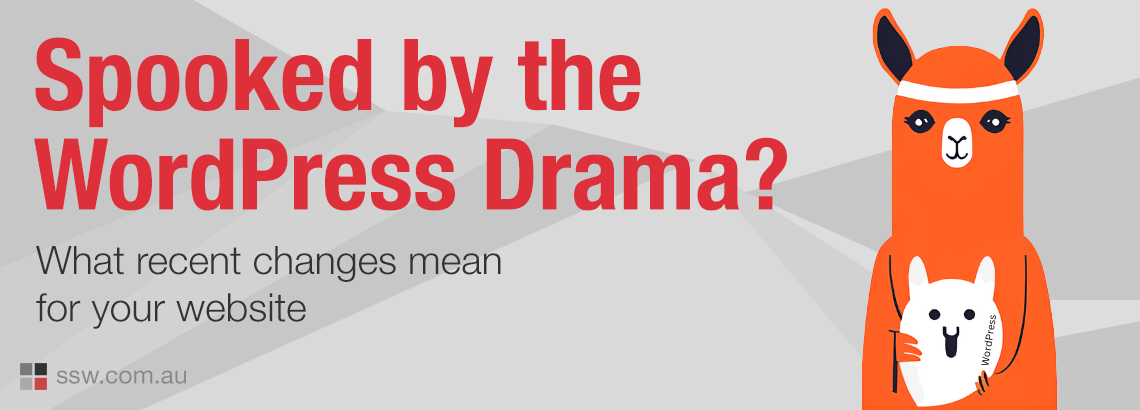Spooked by the WordPress drama? What Recent Changes Mean for Your Website👻
Halloween in the USA 🎃
I’ve just come back from the USA, where I experienced my first real Halloween and USA election. Just about everyone dresses up, and the whole street is decorated for the spooky season!


Talking about spooky, nothing is more scary than what’s been happening with WordPress. Many of our clients were wondering “what’s going on” as tensions rose between Automattic and WP Engine. As the owner of Tina.io, one of the many competitors to WordPress, I decided to give you my take.
First of all, these concerns go beyond just the CMS community and may signal larger issues for open-source platforms.
WordPress is the most popular website-making platform, powering nearly half (43%) of the web in 2024 – this is double what it was 10 years ago in 2013 (25%). In the CMS space, WordPress is the leader taking 61% market share.
🫖 The tea – What happened?
It’s just a Trademark, right? 🤔
The current drama revolves around legal disputes between Automattic (the company who do hosting at WordPress.com) and WP Engine – the leading WordPress hoster – they also own popular themes and plugins.
When it comes to hosting your site, you have a lot of options. Users can either go with WordPress.com, or use an external provider such as WPEngine.com for enhanced performance, and freedom to install any plugins.
WordPress (the free software) is licensed under the GNU Public License allowing users to run, modify, and distribute it freely – ensuring that the tool remains open source. However, this does not cover the WordPress logo and name – these are trademarked under the WordPress Foundation.
Interestingly, the WordPress Foundation recently updated its trademark policy – notably where it once stated on the archived site:
“The abbreviation “WP” is not covered by the WordPress trademarks and you are free to use it in any way you see fit”
To the current site:
“The abbreviation “WP” is not covered by the WordPress trademarks, but please don’t use it in a way that confuses people. For example, many people think WP Engine is “WordPress Engine” and officially associated with WordPress, which it’s not. They have never once even donated to the WordPress Foundation, despite making billions of [sic] revenue on top of WordPress.”
Here’s where it gets juicy 🎃
Following this policy change, a trademark license agreement was sent from Automattic to WP Engine on September 20th 2024. This agreement requested that WP Engine pay an 8% cut of their gross revenue monthly to the WordPress Foundation. This agreement was subsequently declined by WP Engine. And that’s when the sh*t hit the fan…
WordPress CEO Matt Mullenweg, published a blog, ‘WP Engine is not WordPress’. WP Engine filed a cease and desist against Mullenweg – ordering him to stop making ‘salacious and outrageous claims’. Automattic responded with their own cease and desist against WP Engine for using their trademark incorrectly.
Up until now, this drama was just a series of legal back and forth – however, on September 25th Mullenweg released an alarming blog post ‘WP Engine is banned from WordPress.org’
What does this mean for WordPress developers and end users?
In short, it’s bad all around. For those relying on WP Engine hosting, an update was deployed that blocks WP Engine servers from connecting and downloading anything from the WordPress servers. WP Engine plugins that are installed will no longer get updates and users will not be able to add plugins from the .org repository.
Essentially, a move that says: “These are my toys, I’m taking them and going home – figure it out yourself”.
A concern for many companies relying on WP Engine hosting is security. With no automated updates for core and plugins, sites might become vulnerable to security threats unless users take proactive steps.
The unspoken problem – Your content should not be locked away
The WP Engine ban has been a wake-up call and during NDC Porto in October, it was the main topic of conversation at the TinaCMS booth. We explained that there was an additional problem beyond the hosting dramas. That is if the hoster died, you’d have to scrape your content as the data is locked away in a database.
TinaCMS is the only headless CMS where your data is in Markdown files (.md) stored in your GitHub repo. So you get simplicity, headless CMS flexibility (see 🟥#1 below), and control of your data. It is the only CMS that in 30 years, you’ll have no dramas getting your data.
Check out tina.io to explore how easy it is.
By transitioning to TinaCMS, users can avoid the risks of being locked into the WordPress ecosystem and take full control over their content and development workflow.
Has this situation scared you into reconsidering your CMS? Let me know in the comments! ⬇️
More information:
🟥#1 Headless CMS Flexibility 🦙
TinaCMS is also open-source and designed to work seamlessly with modern JAMstack architectures – providing a developer-first approach when compared to WordPress.
Unlike WordPress, TinaCMS operates in a headless manner – meaning that developers have full freedom to build with their favorite front-end e.g. Next.js, Astro, Hugo, Gatsby, and host on the platform of their choice. More importantly, your content is not locked into a content proprietary DB – it’s stored in Markdown so you can take it anywhere.
When it comes to modern website development, TinaCMS stands out by seamlessly integrating with development tools like GitHub and Next.js. It allows content to be managed as Markdown files or JSON, which is directly embedded within the Editorial Workflow, giving developers control over their content structure and editing process. This setup provides the kind of version control and collaboration benefits that WordPress doesn’t natively offer, ensuring smoother, developer-friendly content management and deployment strategies.
